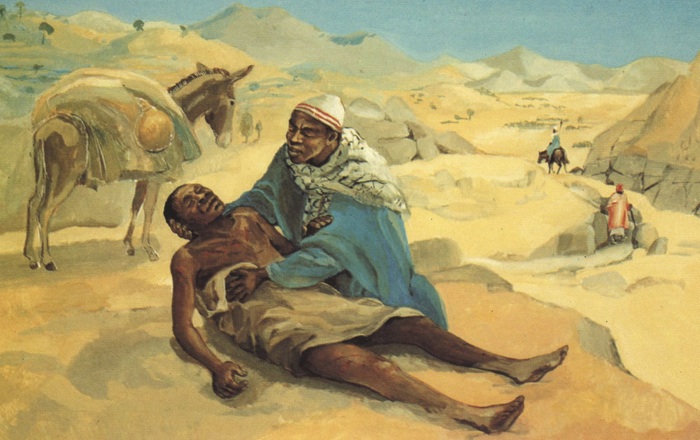Commentary on Amos 7:7-17
Justice and judgment — are they an inseparable pair?
Amos in context
Scholars generally agree that Amos was a southerner, heralding from the village of Tekoa, about five miles from Bethlehem. He was likely active during the mid-8th century; during the period in which Jeroboam II ruled Israel and Uzziah was king in Judah. Both kings had remarkably long reigns, 41 and 52 years respectively, suggesting an era of stability on both sides of the border. From reading the book of Amos — filled with dire predictions of Israel’s future accompanied by oracles of judgments–it’s hard to imagine that Amos is actually living in a time of relative prosperity and peace but this appears to be the case in both kingdoms. Amos’ calling, as the early chapters of the text demonstrate, was to travel north from Judah to preach among the people of Israel.
Spurned messenger
Amos has come to be known for his emphasis on justice, particularly on what we would call social or economic justice. We need only say, “Let justice roll down like waters…” and Amos comes to mind. He was concerned about the poor, the marginal, and the exploited in his society. He is unwavering in his sense that unless these wrongs were “righted,” then there was little hope for Israel. Today’s passage, Amos 7:7-17, clearly demonstrates that neither the message nor the messenger was particularly well-received. Amaziah, the priest at the sanctuary at Bethel, doesn’t mince words, telling Amos, “O seer, go, flee away to the land of Judah, earn your bread there, and prophesy there; but never again prophesy at Bethel, for it is the king’s sanctuary, and it is a temple of the kingdom” (7:12-13).
Amos’ vision
What has Amos said this time, to so upset the northern priest? The image of God that Amos paints for Amaziah is in fact quite disturbing. Amos reports the vision that he has seen in which God tells him, “See, I am setting a plumb line in the midst of my people Israel; I will never again pass them by; the high places of Isaac shall be made desolate, and the sanctuaries of Israel shall be laid waste, and I will rise against the house of Jeroboam with the sword” (7:8-9).
Although “plumb line” is used to translate the Hebrew is ’a·na? in the NRSV, it isn’t entirely clear that this is what the word actually means. Amos 7:7-8 is the only passage in which this term appears in the Hebrew Bible, and while its origins are unknown, it seems to refer to a metal, perhaps lead or tin. In some earlier translations to English, a “mason’s trowel” is used instead of a plumb line. The Jewish Study Bible, strikingly, translates the term as “pick ax.” This translation works in that it is consistent with the image of God with a sword at the conclusion of verse 9. Both the pick ax and the sword communicate the destructive thrust of the passage — God holding instruments suggesting imminent devastation.
What is interesting is how consistently tradition has favored the term “plumb line” over other possibilities in interpretation and translation. And, how the image of the Lord with a plumb line is emphasized over against the image of God with a sword in verse 9 in both. This may have more to do with our piety than with the text itself: a plumb line is not inherently destructive, but is used in the process of construction to make sure that lines are straight. Unlike a sword or pick ax, a plumb line gives the sense that there is still hope to make adjustments!
Images of justice
When we consider symbols of justice in our culture, Lady Justice likely springs to mind. This woman (sometimes with a blindfold), who carries a set of scales in one hand and a sword in the other, is everywhere–from the Supreme Court to the local courthouse. The origins of this depiction can be traced as far back as ancient Egypt, to the goddess Ma’at, whose name indicates “straightness” both in the construction of buildings as well as in human behavior. This female depiction of justice continued to develop, first in Greek culture as Dike, daughter of Themis, and then in Roman culture as Justitia. Throughout history, different features have been added and she has been called by many names, but the Roman goddess, Justitia, has stuck in western culture so that we know her as Lady Justice. Her scales represent the ability of Lady Justice to weigh evidence fairly and impartially. Her sword can represent both her authority to make such decisions as well as her capacity to execute judgment.
What do we do with a God of judgment?
We can wholeheartedly stand with Amos in many other passages through his book as he demands justice and exposes corruption and exploitation. We also take pride in the scales of Lady Justice as the foundation of fairness in our society. But both Amos and Lady Justice have a darker side, that of judgment. Even if Amos’ God is holding a plumb line in the first part of the passage — a device akin to the weighing and measuring capacity of Lady Justice’s scales — God is clearly using a sword in verse 9 against the house of Jeroboam II. These images of the sword (and perhaps the pick ax as well) are disturbing. Even more problematic, in the passage from Amos, is that time for taking action or returning to the Lord appears to have run out. The case, in fact, appears to have been decided and the punishment at hand.
What “word” is there for us in this passage? Is there a place for judgment in our preaching today? Perhaps, a closer look at Lady Justice will provide some clues. She holds both the scales and the sword — maintaining the tension between justice and judgment, and suggesting that justice without judgment is meaningless. What if we consider Amos in the same way, a prophet who was gripped by visions of both justice and judgment — a pair that couldn’t be separated?


July 14, 2013